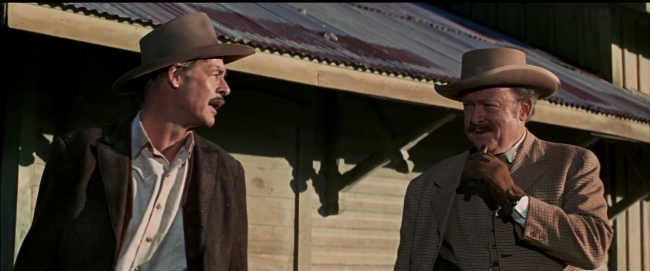
Two outlaws, two men of the west, are best friends until one of them switches sides to work for the law. Now one hunts the other. This could describe several Sam Peckinpah films but to-day I'm talking about 1969's The Wild Bunch, a decent Western that wrestles with the difference between following a personal moral code and adhering to social and legal expectations. I like Peckinpah's Pat Garrett and Billy the Kid better--it's basically the same story but with a better soundtrack.

The frenemies in The Wild Bunch are Pike and Deke, played by William Holden and Robert Ryan, respectively. I like both actors though I felt Ryan came off a little better and I would have preferred more focus on his personal struggle in pursuing his friend in his new role as a legal killer. But then I guess that would basically be Ride the High Country, which I do like better. Holden is fine in this but Ryan seems more focused somehow.

Mostly I don't find the film very interesting visually. I liked the look of two scenes--one where the criminal gang visits a Mexican village, the home town of one of the gang members, Angel (Jaime Sanchez), because I liked the persistent, really vibrant green foliage in the background as a contrast to the grey and brown foreground stuff.

Angel draws the group into the main contextual conflict, you might call it, being the Mexican Revolution. Angel is a straight forward heroic character, hoping to save his people from the tyranny of Mapache, a general in the Federal Army who, like a typical dictator, divides most of the time between trying to make himself look like a big shot and partying.

This adds fuel to the fire of the movie's argument about the illegitimacy of traditional government figures compared to the moral authority of tough individuals. The other visual I liked in the film is when Pike's gang meets with some of Pancho Villa's forces who take a case of the guns the group stole from a U.S. train. Why Villa's troops don't simply take all the guns, I don't know.

I guess what impressed me most about the film was the stunt work. People do some really dangerous looking things in this movie--in one early bank robbery scene, I don't know how one person avoided getting trampled by a horse. I wouldn't be surprised to learn there were injuries on the set. I have a bad feeling horses may have been hurt during the making of this movie.

All the women in the film, none of whom becomes a full fledged character, are either completely docile or completely treacherous. I guess moral complexity is left to the menfolk. A scene where the group visits some prostitutes at the end cuts between a bizarre encounter between Pike and a prostitute who kind of blankly stares at him while she does her hair and two other gang members trying to get out of paying another prostitute.

No comments:
Post a Comment